
.

.

.

.

.

.

.
 Shop
Shop

This is an Ad. Advertised sites are not endorsement by our Forum. They may be unsafe, untrustworthy, or illegal in your jurisdiction. Advertise Here
This section allows you to view all posts made by this member. Note that you can only see posts made in areas you currently have access to.
Messages - stormgain
Pages: 1 2 3 [4] 5 6 ... 37
46
« on: January 23, 2024, 12:31:20 PM »
Bitcoin outflow from Grayscale's fund exceeds $5 billion
The emergency of spot Bitcoin ETFs in the US is putting downward pressure on the crypto. The conversion of Grayscale's trust fund into a Bitcoin ETF, with over 620,000 BTC worth $28.6 billion as of the transformation date, was one of the key reasons.

Now, the GBTC fund has $23.5 billion in its piggy bank. The outflow amounted to $5.1 billion or 18% over ten days.
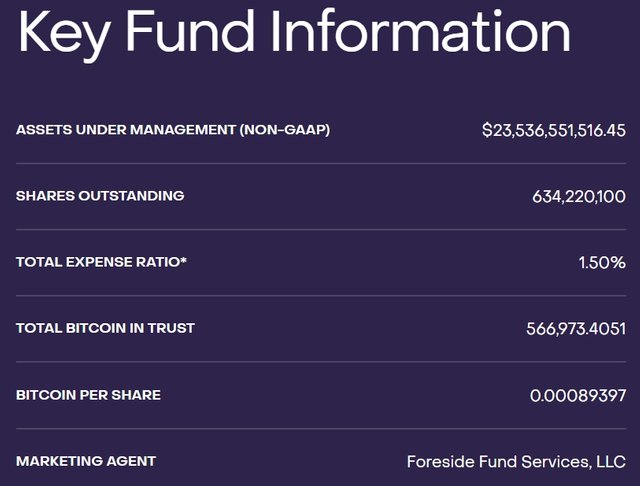
Last June, the discount on the fund's shares relative to the underlying asset was over 40%, but after Grayscale won its appeal against the SEC, it rallied sharply. Savvy players started buying up the fund's shares, investing about $3 billion.

This amount can be considered non-refundable, meaning it isn't driven by interest in Bitcoin directly but only by a desire to profit from the reduction in the discount due to the upcoming conversion.
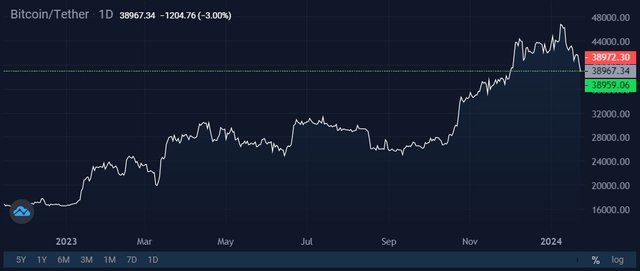
The rest of the outflow volume is due to the GBTC's high fees for fund management. The fees are way higher than competitors', coming in at 1.5% versus 0.2%-0.5% (excluding the free period). Note: Hashdex doesn't count because they were approved for a futures ETF, not a spot ETF.
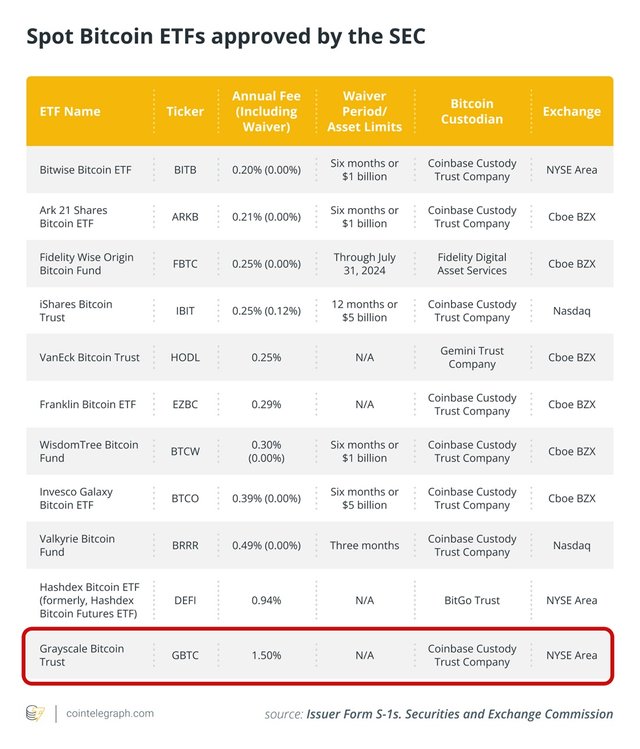
Grayscale CEO Michael Sonnenschein, defending the high fees, has said there is a risk of bankruptcy for most spot ETFs over the long run. He was supported by Quantum Economics founder Mati Greenspan: "Having a dozen ETFs for one asset is pretty ridiculous."
Based on the last six days, inflows into exchange-traded funds still exceed outflows from Grayscale by $1.1 billion.
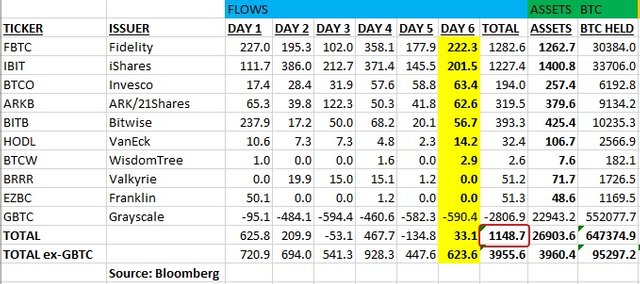
However, this data doesn't consider outflows from futures ETFs of more than $3 billion since the launch of spot ones. Futures funds are more burdensome for investors due to losses when switching from contract to contract.
The dynamics of exchange-traded products are turning negative, which hurts Bitcoin. Miners also contributed, sending $5 billion worth of Bitcoin to crypto exchanges in the first three days after the launch of ETFs (read more here - https://stormgain.com/blog/miners-are-disposing-of-bitcoin-in-record-volumes).
StormGain Analytical Group (https://stormgain.com/)
(platform for trading, exchanging and storing cryptocurrency)
47
« on: January 22, 2024, 08:40:12 AM »
Illegal crypto transactions make up 0.34% of total volume
This week, JPMorgan CEO Jamie Dimon cited money laundering, fraud, tax evasion and sex trafficking as key uses of Bitcoin. This assessment is typical for all fierce opponents of digital assets who consider the latter to be a tool used by criminals.
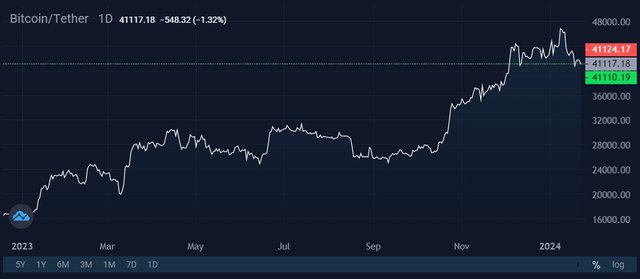
However, a chain analysis of transactions of addresses flagged as suspicious by law enforcement suggests otherwise. Yesterday, the Chainalysis analytics agency released a report in which criminal activity accounted for just 0.34% of total transaction volume.
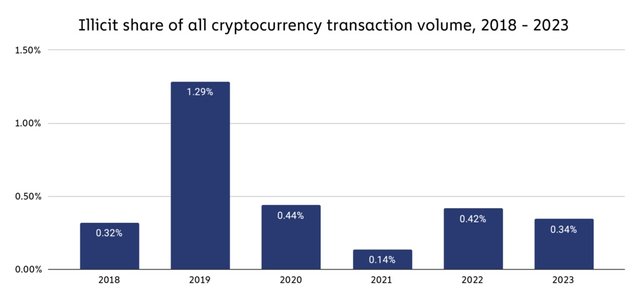
In absolute numbers, $24.2 billion worth of illegal transactions were made using cryptocurrencies in 2023.
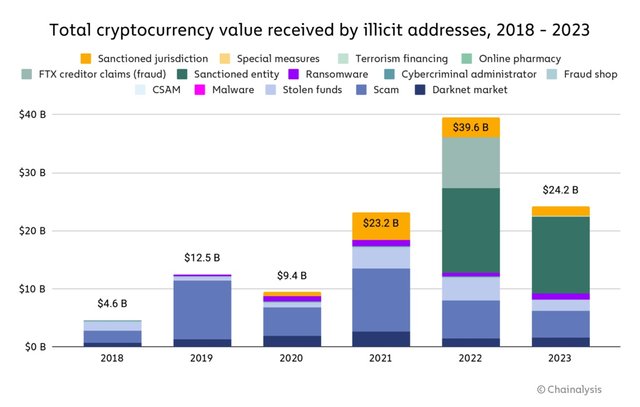
Of these, 61.5% of transfers worth $14.9 billion were made to evade sanctions. These are mostly addresses flagged by the US Treasury Department's Office of Foreign Assets Control (OFAC). This category grew significantly in 2022, when Russia rose to first place in terms of the number of international sanctions applied.
In terms of 'traditional' illegal activities, such as the use of malware or fraud, there has been a decline in transaction volumes since 2021. In 2023, the volume of the above-mentioned category decreased by 29.2%, while the volume of hacking attacks dropped by 54.3%.
Some pretty interesting changes also occurred in terms of cryptocurrency preferences. Up to and including 2021, Bitcoin accounted for most illegal transactions. Since 2022, however, it has ceded that title to stablecoins. The latter were mostly used to evade sanctions.
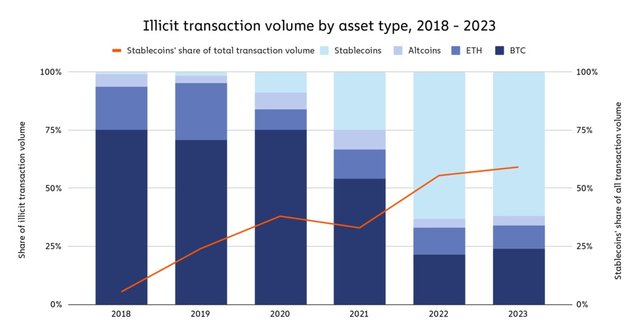
The recent claims by the UN Office on Drugs and Crime against Tether can be summed up as follows:
"Law enforcement and financial intelligence authorities in East and Southeast Asia have also reported USDT [or Tether] among the most popular cryptocurrencies used by organised crime groups..."
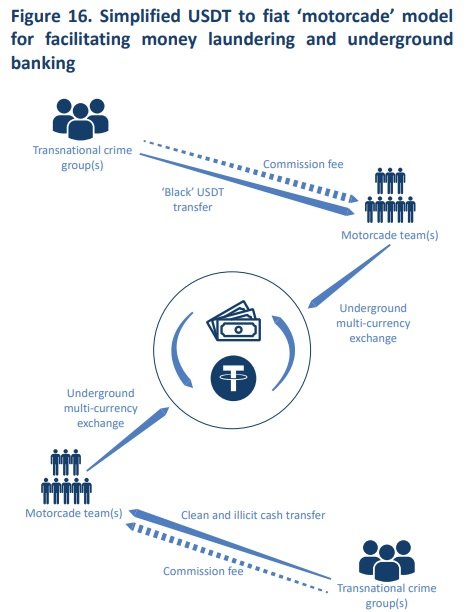
Tether criticised the UN agency, hinting at its insufficient competence:
"The UN's analysis ignores the traceability of Tether tokens and the proven record Tether has of collaborating with law enforcement".
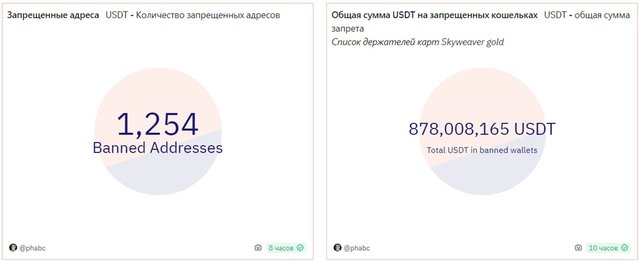
The company has repeatedly noted that it promptly blocks suspicious addresses upon receiving the first official request from law enforcement agencies. Currently, 1254 addresses that hold a total of $878 million are included on the stop list.
StormGain Analytical Group (https://stormgain.com/)
(platform for trading, exchanging and storing cryptocurrency)
48
« on: January 19, 2024, 10:18:09 AM »
TUSD loses its peg to the US dollar
The stablecoin market has seen better days and is still suffering from the collapse of the UST stablecoin. The total capitalisation for stablecoins has gone from a high of $188 billion at the beginning of May 2022 to just $134 billion now.
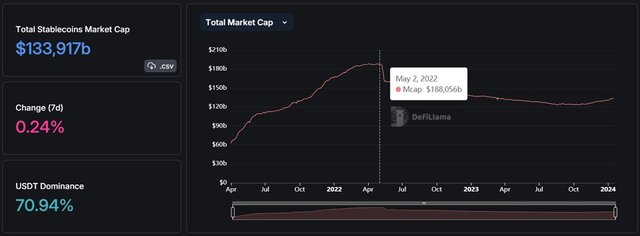
This time, the fifth-largest stablecoin TrueUSD (TUSD) from Techteryx, a British Virgin Islands-registered company, is facing shocks. Its rate was down to $0.97 on most crypto exchanges yesterday and dropped to as low as $0.92 on Poloniex two days earlier.
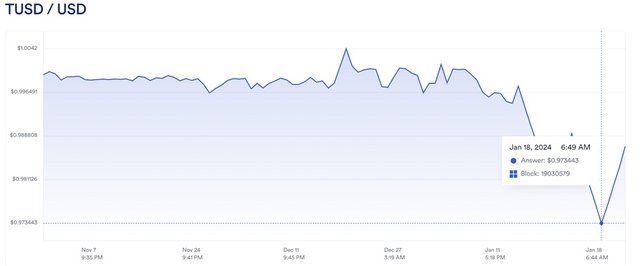
Despite its $2 billion capitalisation and seven-year history, TUSD is surrounded by scandals and unexpected twists and turns. For example, its capitalisation soared from $1 billion to $3 billion thanks to Binance, which introduced zero fees on it in March 2023.
Six months later, the cryptocurrency exchange cancelled the beneficial terms for TUSD after a major unpegging from the US dollar took place in June. Since that time, the coin's capitalisation has gone down.

The reason for the rate volatility in the summer was the filing of a lawsuit by TUSD founder Archblock (Techteryx acquired the business in 2020) against Justin Sun, in which the latter is accused of secretly accumulating a significant amount of TUSD for subsequent market manipulation.
It's worth noting that $1.5 billion of the current $1.9 billion capitalisation was minted on Justin Sun's TRON blockchain.
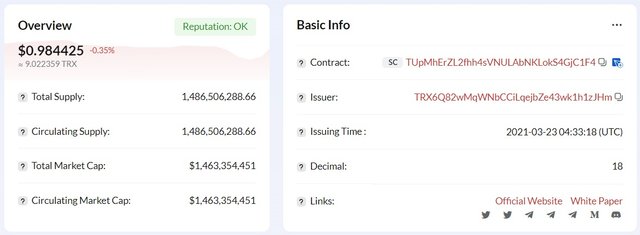
In the same year, TUSD faced a massive sell-off due to criticism of the lack of transparency of reserves and community suspicions that there were none after a widget on the official website malfunctioned. According to Binance, the outflow of funds exceeded $40 million on 15 January alone.
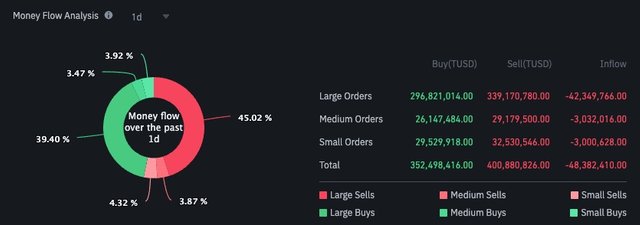
Panic was fuelled by rumours about the inability to deposit/withdraw TUSD from Poloniex, including for arbitrage trading. This was the reason for the exchange rate's decline on 16 January to $0.93 exclusively on this platform. Earlier, Poloniex was acquired by Huobi, in which Justin Sun is the majority shareholder.
In both cases, the loss of confidence in the coins involves Justin Sun to some degree. He undoubtedly has the financial means to support the rate directly if he wanted to. For now, he denies all accusations of involvement in the fate of the stablecoin. The TRX rate on the TRON network wasn't affected by the events.
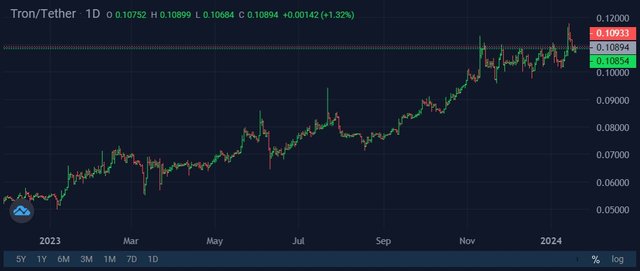
However, given all the twists and turns, market participants should be extra cautious when using TUSD. Last year, S&P Global released a stablecoin rating that ranked it last along with FRAX.
StormGain Analytical Group (https://stormgain.com/)
(platform for trading, exchanging and storing cryptocurrency)
49
« on: January 18, 2024, 09:04:24 AM »
Factors for Bitcoin's fall
The approval of spot Bitcoin ETFs in the US was a major step towards institutionalisation, but it caused Bitcoin to fall 14% from its local high. We warned (https://stormgain.com/blog/etf-approval-will-trigger-bitcoin-fall) about such an outcome back at the end of the year. There are several objective reasons for this, which are worth outlining.
High expectations
Bitcoin's price rose 2.5 times in 2023, and much of the growth came in the autumn when the emergence of ETFs became inevitable.
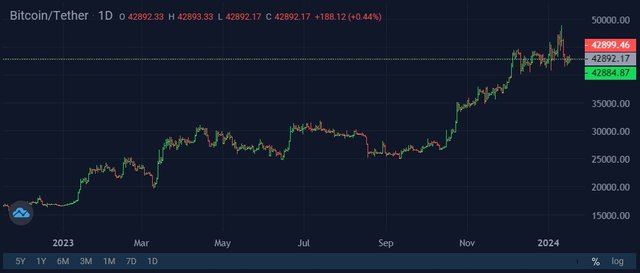
This has led to a significant increase in unrealised gains among short-term holders (STH), who are characterised by a rapid mood change and a desire to take profits at the first signs of a correction.
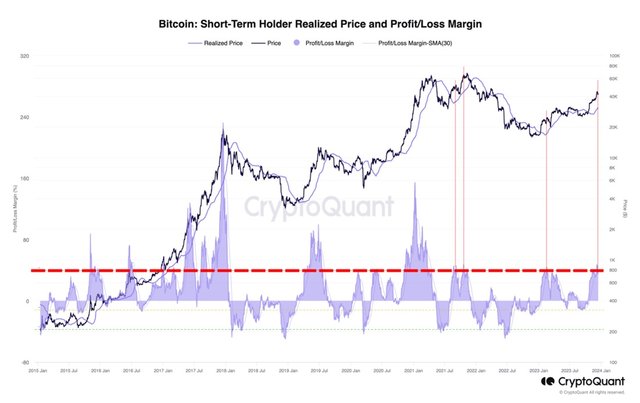
Derivatives traders can also be considered STH as they actively increased their purchases as 10 January approached. The funding rate clearly demonstrates this. Its growth indicates the prevalence of bulls over bears in open futures contracts. As hopes for Bitcoin to skyrocket with the emergence of ETFs failed to come true, the bulls rushed to the exits at the first signs of a correction. The rate is now close to neutral.

Sluggish start
The emergence of spot Bitcoin ETFs didn't stir markets. In the first two days, they attracted only $1.2 billion in investments. Compare that to one futures ETF that recorded a $1.5 billion gain in 2021. The weak performance is also evidenced by relatively low trading volumes in both the spot and derivatives markets.
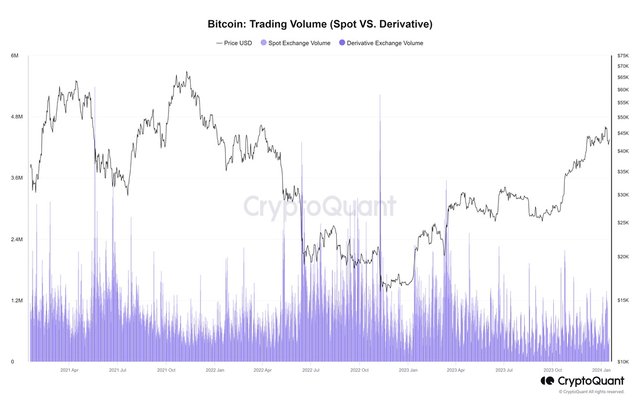
Capital shifts
The emergence of ETFs caused a capital shift among funds. Grayscale was converted from a trust fund, so it started with 618,000 BTC. What's more, the company has the highest commission for managing assets. Its 1.5% fee led capital to flee. In recent days, around 10,000 BTC (~$430 million) has been transferred to Coinbase to be subsequently sold. With the start of the sell-off, added pressure hit the market.

A similar pattern is seen with outflows from futures ETFs, as switching from contract to contract imposes additional costs on investors.
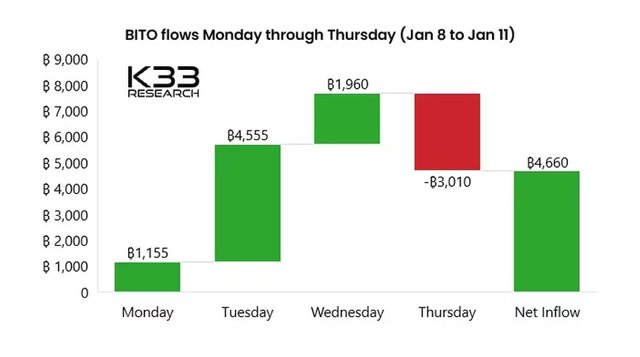
Miners' sell-off
Miners followed the classic "buy rumours, sell facts" technique and sold off 111,000 BTC worth $5 billion in the first three days after the ETF launch. Whales joined in, too. The number of addresses with over 1,000 BTC dropped from 2,024 at the end of last year to the current level of 2,015.
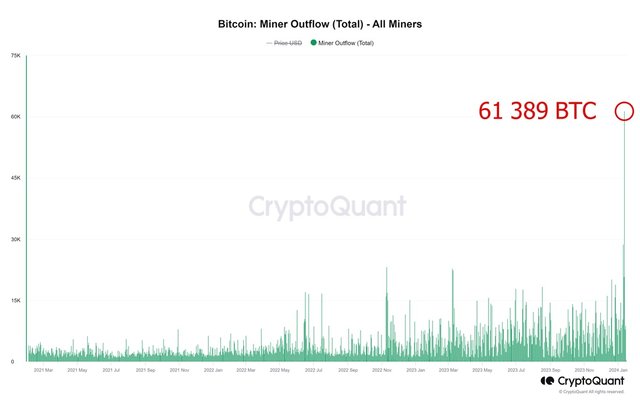
As we can see, some market participants used the ETF hype to sell part of their assets, while others fell victim to high expectations. However, the above factors in no way diminish the significance of long-term trends and the emergence of exchange-traded funds.
StormGain Analytical Group (https://stormgain.com/)
(platform for trading, exchanging and storing cryptocurrency)
50
« on: January 17, 2024, 03:23:33 PM »
Crypto funds set a record turnover of $17.5 billion
The first financial statistics on Bitcoin ETFs launched last week in the US have been released. New records were set: the total trading volume of new and existing crypto funds for the week reached $17.5 billion, with an average of $2 billion. However, the inflow figure failed to beat the effect of the launch of a futures ETF in the US in 2021, when the numbers were $1.2 billion and $1.5 billion, respectively.
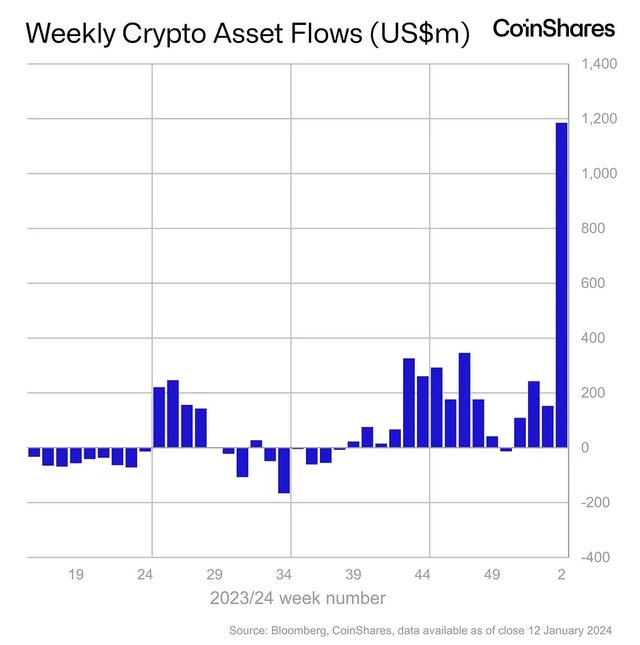
Among the approved ETFs, the one from BlackRock, the world's largest company by assets under management, predictably saw the highest rise. In just two days, it raised $0.5 billion in investments. Grayscale, on the other hand, showed an outflow of $0.6 billion.
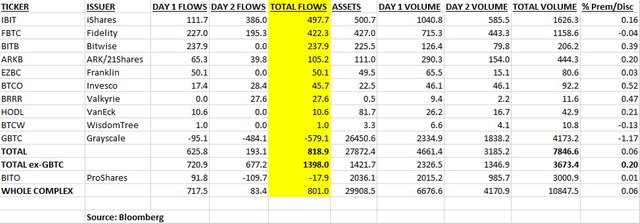
It's worth explaining that Grayscale, unlike other participants, started this stage with 618,000 BTC (~$28 billion) on board due to the transformation of its trust fund into a spot ETF. Such an impressive margin tempted the company to charge the highest commission of 1.5% for management services. Outflows into lower-cost ETFs are likely to continue in the long term.
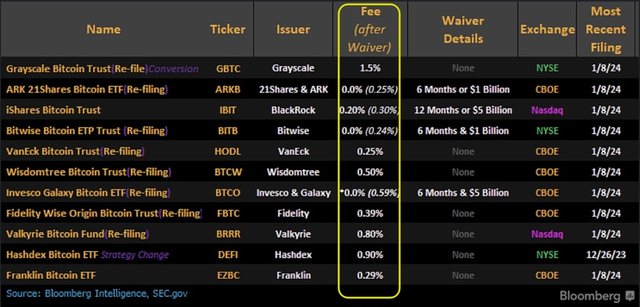
Looking at last week's inflows by asset, $1.1 billion came from Bitcoin, with Ethereum coming in second with $25.7 million.
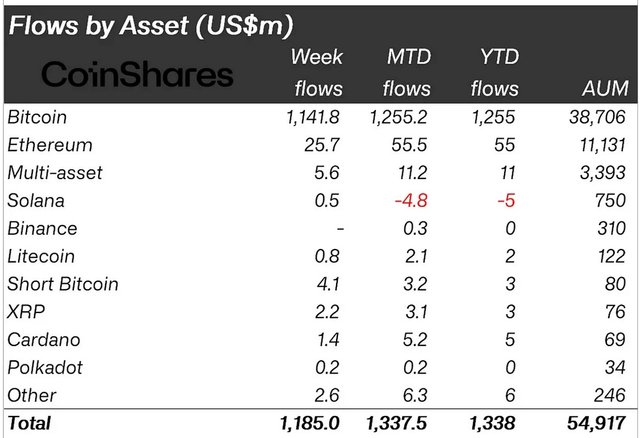
For 2023, inflows into the altcoin look extremely dim, with $78 million, half the size of Solana ($167 million). The low demand for Ethereum from institutional investors is due to attacks from the SEC, the forced withdrawal of several US cryptocurrency exchanges from staking, and the significant lag in momentum behind Bitcoin.
Last week, BlackRock CEO Larry Fink drew attention to the altcoin by announcing his interest in the emergence of spot Ethereum ETFs.
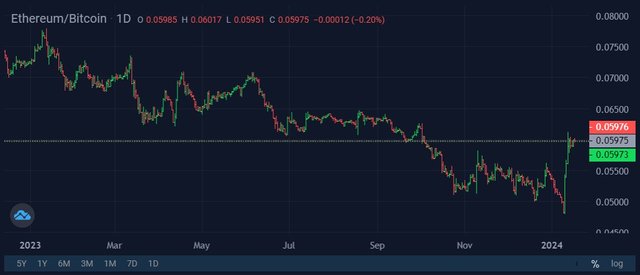
However, investors should take into account the words of SEC Chairman Gary Gensler. In the accompanying letter to the approval of the ETFs, he noted two important circumstances: the regulator considers Bitcoin to be a commodity only and was forced to launch crypto funds by a peculiar interpretation of the law by the courts (meaning the SEC's loss in Grayscale's appeal).
All of this makes it unlikely that spot ETFs for any altcoin will appear in the US in the near future.
StormGain Analytical Group (https://stormgain.com/)
(platform for trading, exchanging and storing cryptocurrency)
51
« on: January 16, 2024, 08:11:55 AM »
Miners selling record volumes of Bitcoin
Miners have played out the classic "buy the rumours, sell the facts" scenario. In the three days since spot Bitcoin ETFs were approved, miners sent 111,000 Bitcoin worth $5 billion to crypto exchanges. The highest volume over the past six years was set on 12 January, when crypto miners transferred 61,400 BTC.
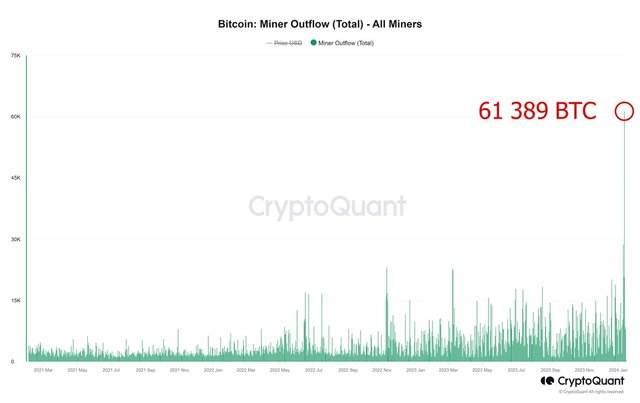
Miners send coins to crypto exchanges to then sell them. This huge outflow is due to fears of the upcoming halving. The event that halves the reward for mining a block may come as soon as April.
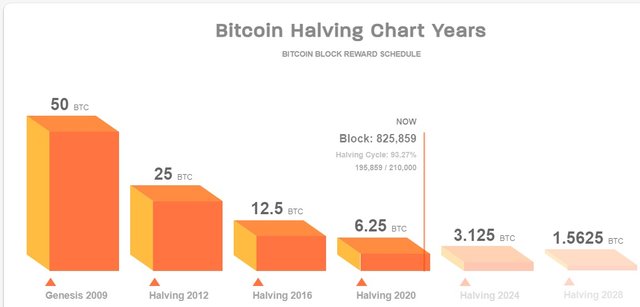
The average cost of Bitcoin mining, according to the MacroMicro portal, is $46,500, while the market price of the cryptocurrency is only $42,700.
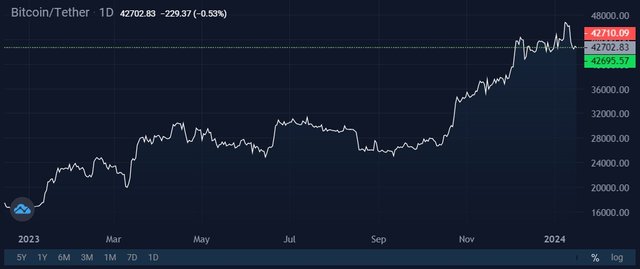
On average, mining remains unprofitable due to extremely high competition. Large miners are actively increasing mining capacity and looking for ways to reduce costs. When weak companies become unprofitable due to growing losses, their capacity is bought up by more efficient competitors.
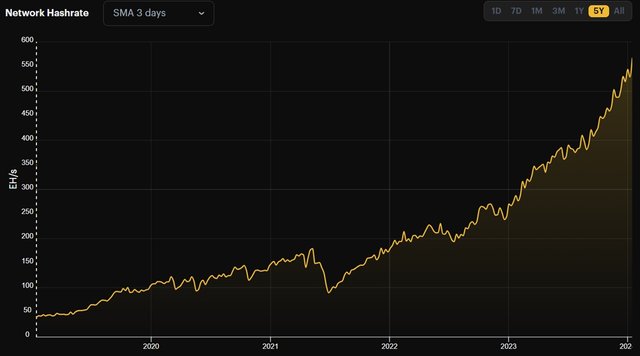
Electricity accounts for around 70% of all Bitcoin mining costs. As a result, mining companies either switch to alternative energy sources or move to regions with low electricity costs. TeraWulf's direct connection to a nuclear power plant in the US without dealing with distribution grids can be considered one of the best solutions so far. This allowed the company to lock in a rate of $0.02 per kWh for five years.
CoinShares analysts have calculated the cost of crypto mining for the top public miners. Only five out of the 14 companies examined will have a cost of production below $40,000 per coin after halving.
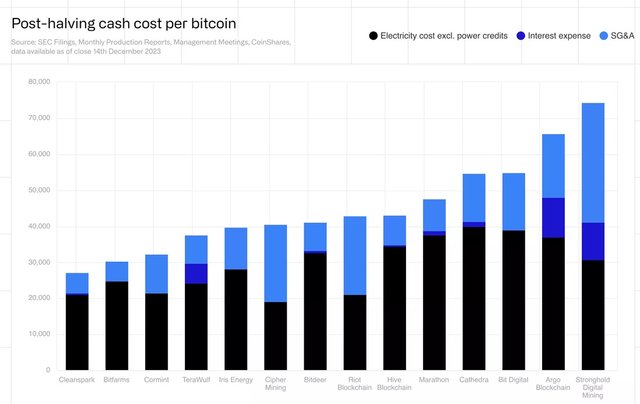
The vast majority of them continue to build capacity in hopes that the cryptocurrency's price will rise. In their investment estimates for 2024, the price of Bitcoin is in the range of $60,000-100,000. If the forecasts don't pan out, a lot of negative shocks await miners this year, and all newly mined coins will be sent directly to crypto exchanges.
StormGain Analytical Group (https://stormgain.com/)
(platform for trading, exchanging and storing cryptocurrency)
52
« on: January 12, 2024, 09:12:52 AM »
SEC: We approved ETFs, not Bitcoin
The first application for a spot ETF submitted to the SEC was from the Winklevoss twins back in 2013. It was rejected in 2017. Despite the time that's passed, the regulator's views on the nature of digital assets haven't changed in the slightest. Here's the statement that accompanied yesterday's approval of ETFs (the full text of the statement "https://www.sec.gov/news/statement/gensler-statement-spot-bitcoin-011023"):
"…bitcoin is primarily a speculative, volatile asset that's also used for illicit activity including ransomware, money laundering, sanction evasion and terrorist financing. While we approved the listing and trading of certain spot bitcoin ETP shares today, we did not approve or endorse bitcoin".
The statement's overall message boils down to this: the SEC would have continued to block the emergence of the investment product if it hadn't been for the judges' particular interpretation of securities law. However, continued rejection would be impossible given the court's ruling in Grayscale's favour in a case about converting its trust fund into a spot ETF.

The interpretation of the cryptocurrency's status is of great interest to investors. The SEC still refers to Bitcoin alone as a commodity, while "the vast majority of crypto assets are investment contracts (i.e., securities)".
In other words, hopes that spot ETFs for Ethereum and other cryptocurrencies will soon emerge are baseless. However, some media outlets attribute Ethereum's surge over the last 24 hours to this very hope.
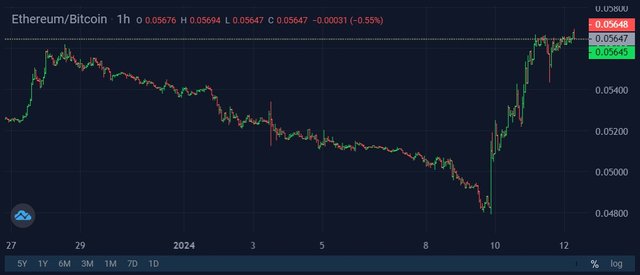
It'll take time to assess the real effect the launch of the spot Bitcoin ETF has had. The funds will take about a week to be listed on exchanges, and figures on investment volumes will start coming in in about a month.
Currently, 11 ETFs have been approved, including ones from BlackRock and Fidelity, each of which manages over $10 trillion in assets.
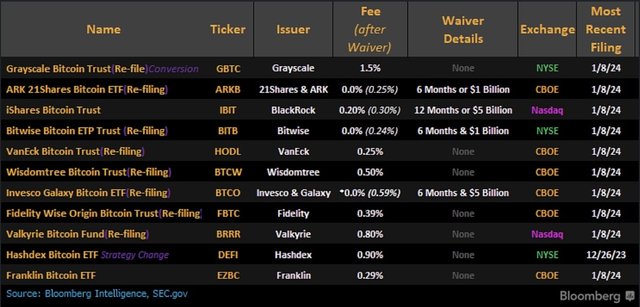
For an idea of potential capital inflows, the US saw $1.2 trillion invested in various ETFs over the past two years. Even if a tenth of that is redirected into Bitcoin, it would create powerful price momentum. Many analysts compare the expected outcome of the emergence of these Bitcoin ETFs with the gold ETFs launched in 2004. In seven years, the price grew four-fold, with over $100 billion being held in gold ETFs.
The majority of estimates think that Bitcoin will hit an all-time high as early as this year.
StormGain Analytical Group (https://stormgain.com/)
(platform for trading, exchanging and storing cryptocurrency)
53
« on: January 11, 2024, 10:03:34 AM »
Open interest in Bitcoin on the CME sets new highs
Today is the deadline for approval of ARK Invest and 21Shares' joint application to create a spot Bitcoin ETF. Investment interest in this event is so strong that the total volume of open Bitcoin futures contracts on the Chicago Mercantile Exchange (CME) broke the high previously set in 2021. That figure is now $6.3 billion.

The likelihood of spot ETFs being approved in 2024 has increased dramatically following the SEC's loss on an appeal brought by Grayscale. The regulator banned the conversion of a trust fund into a spot fund, and the court ruled that the SEC's decision was "arbitrary and capricious". The appeal period for that decision expired last October, so it was only a matter of time before spot ETFs were approved.
Since week 40 (early October), inflows into existing crypto funds with Bitcoin worldwide have exceeded $1.6 billion. This compares to a modest $388 million for 2022.
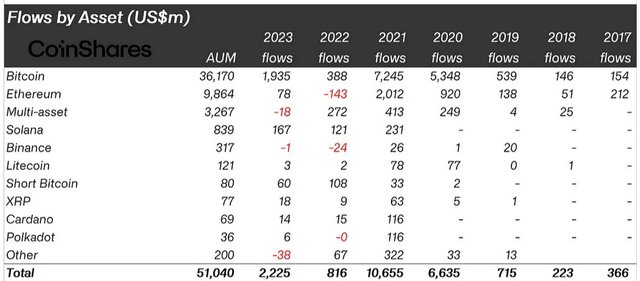
Galaxy Digital estimates ETFs will raise $14 billion in the first year. Standard Chartered (SC) claims that this amount will reach between $50 billion and $100 billion. Such an impressive influx of funds will inevitably lead to an increase in Bitcoin's price. SC estimates that the price will rise to $100,000 by the end of the year.
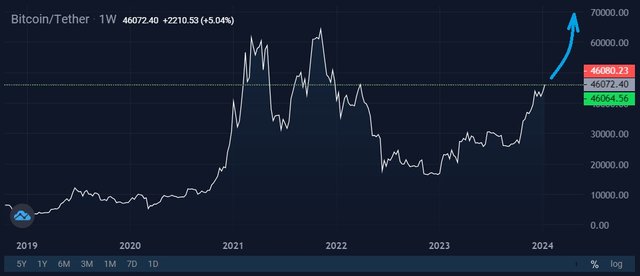
Therefore, speculation around the launch of ETFs is causing increased volatility and unwanted excesses. For example, in the early morning hours of 10 January, the SEC's X (former Twitter) account was hacked, and a post about ETFs being approved appeared. Bitcoin reacted to the news by rising to $48,000. However, within an hour, it rolled back after a denial was published.
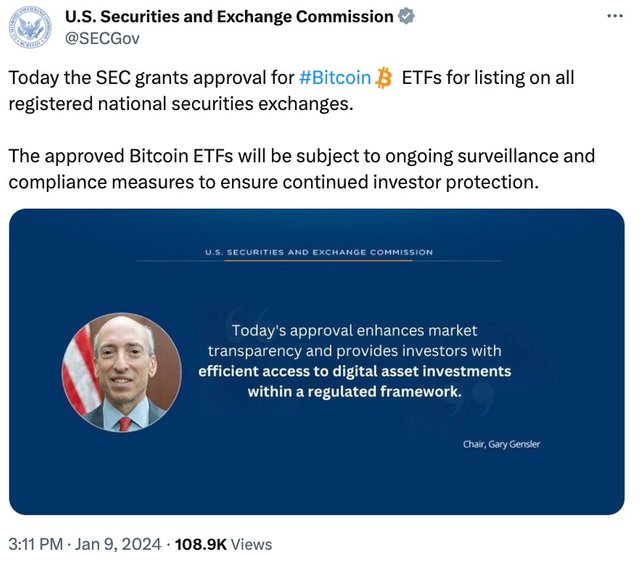
K33 Research warns that Bitcoin might even decline after the long-awaited ETFs are approved. The fact is that 43% of the $2.7 billion in CME futures contracts are held by futures ETFs, which will face significant outflows in favour of spot ETFs due to higher costs. The large-scale closing of positions will put pressure on the price until capital flows into new ETFs.
Whales who prefer to dump reserves on big positive news may also add some pressure. All of this promises increased volatility when spot ETFs are approved, but the long-term outlook remains positive.
StormGain Analytical Group (https://stormgain.com/)
(platform for trading, exchanging and storing cryptocurrency)
54
« on: January 10, 2024, 08:45:12 AM »
First date for potential approval of Bitcoin ETFs on 10 January
Tension is growing in the crypto market as the final deadline for reviewing applications to launch spot ETFs in the United States approaches. The predominance of bullish leveraged positions in the futures market has led to funding rates increasing to record levels over the past year.
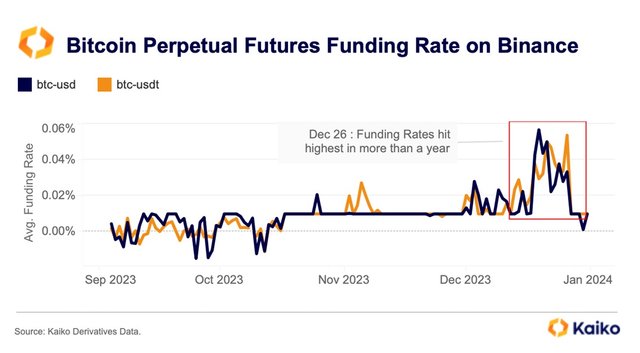
The market heat-up caused increased volatility, while a price drop led to a cascade of marginal positions being liquidated. On 3 January alone, over $0.5 billion worth of bullish positions were closed.

Bitcoin only needed a few days to recover from the wave of sell-offs and overcome the local resistance at $46,000. We warned about the coming increase in volatility in our last article for December.
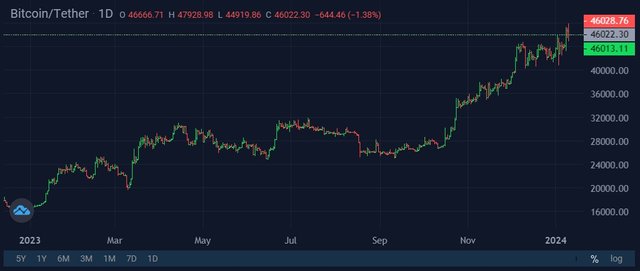
The excitement was caused by the approaching appearance of spot ETFs that will open broad access to institutional capital for the cryptocurrency. The exchange-traded funds could be approved as soon as 10 January, which is the deadline for the SEC to review the joint application from ARK Invest and 21Shares. If the regulator wants to reject the application, it needs to provide compelling arguments, something that won't be so easy given its loss on Grayscale's appeal last year.
Former SEC Chairman Jay Clayton recently said:
"I think approval's inevitable…and I think there's nothing left to decide."
This opinion is shared by institutional investors who invested $151.4 million in crypto in the first week of January, 74% or $112.6 million of which went into Bitcoin funds.

A new warning from the SEC to potential investors hints at the imminent emergence of ETFs:
"You may see your favorite athlete, entertainer or social media influencer promoting these kinds of investment opportunities. Although it's tempting, never make a decision to invest based solely on their recommendation."
Despite all the signs that the applications will be approved in 2024, investors should remain cautious. The first important date is 10 January, but it's not the last: The application from ARK/21Shares could be found to contain mistakes, and a rejection from the SEC would set off a new way of turbulence.
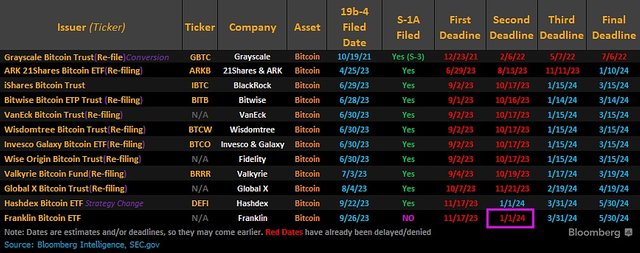
The deadline for most applications is in mid-March. That includes the application from the world's largest company in terms of assets under management, BlackRock.
StormGain Analytical Group (https://stormgain.com/)
(platform for trading, exchanging and storing cryptocurrency)
55
« on: December 29, 2023, 11:27:17 AM »
Bitcoin sets new all-time record for transactions
On Christmas Eve, users completed 723,000 transactions, setting a new record. Transactions involving Bitcoin ordinals accounted for 440,000, which represents 60.8% of the total.
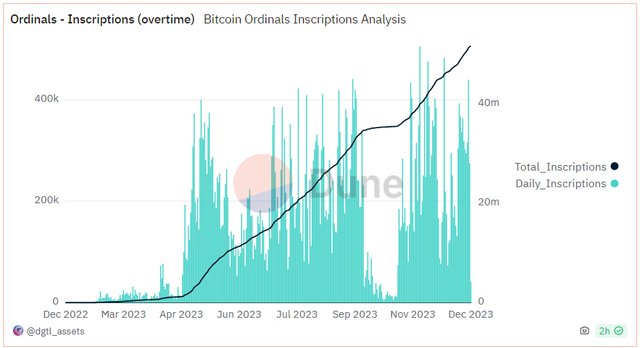
It might appear that ordinals are primarily responsible for heavy network load and increased commission. However, this isn't entirely true, as quasi-tokens distributed over the Bitcoin network use the JSON text format, which takes up little space. Because of this, a single block is densely packed.
Note: Ordinals are digital assets that come in the form of images, video, audio files (ERC-721 analogue), or quasi-tokens (ERC-20 analogue). The speculative hype surrounding quasi-tokens has seen them take up a 90–99% share of all Bitcoin ordinals transactions on the BTC network.
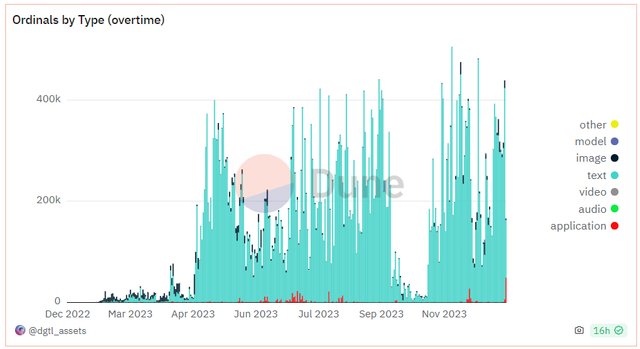
The Ordinals protocol was introduced in February, and the number of transactions since then has skyrocketed to new heights. That being said, Bitcoin ordinals have taken up no more than 20% of the block space since July, according to an analysis by Glassnode.

In other words, the lion's share of transactions are now financial, and the Christmas Eve flurry of activity can be attributed to the desire to send Bitcoin as a gift to family and friends.
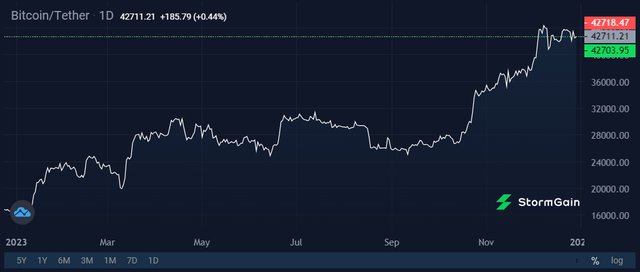
A potentially wise decision in view of the upcoming introduction of spot ETFs in the US and the rally which is expected to ensue. Fox journalist Eleanor Terrett reported on X (formerly Twitter) that the SEC has set December 29 as the deadline for issuers to file their final applications with any amendments incorporated.
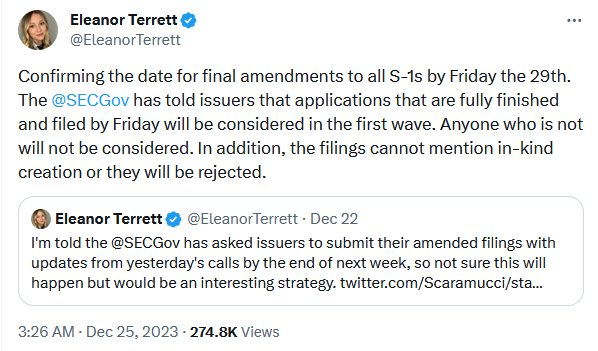
If this plays out, then the chance of seeing ETFs arrive next year has greatly increased.
StormGain Analytical Group (https://stormgain.com/)
(platform for trading, exchanging and storing cryptocurrency)
56
« on: December 27, 2023, 09:41:03 AM »
The 2023 crypto market in five charts
The crypto industry saw plenty of events this past year. We've selected five of the most illustrative charts to show what the year looked like.
The rise of Bitcoin. This year, Bitcoin's market capitalisation jumped 172%, outpacing altcoins by almost double in terms of growth rates. The autumn saw strong momentum when the last arguable obstacle to approving spot ETFs in the US collapsed. On 13 October, the deadline for the SEC to appeal Grayscale's decision to convert the Bitcoin trust fund into a spot ETF expired.
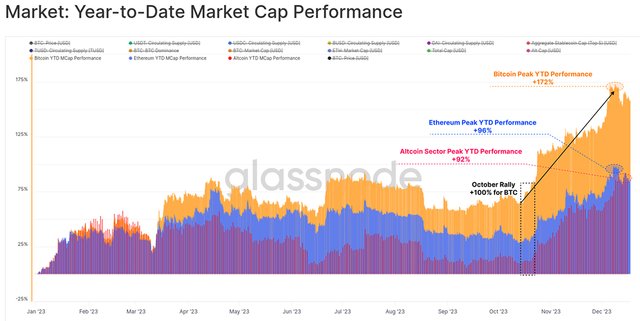
Institutional capital inflows. October saw another turning point in the futures market when open interest on the CME exceeded open interest on Binance for the first time. The Chicago Exchange is now headed towards breaking the all-time high of $5.5 billion set in October 2021. All of this shows the genuine interest of institutional capital in cryptocurrency.
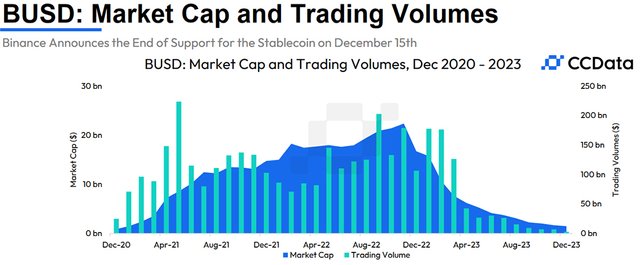
BUSD's decline. US regulators' displeasure with Binance resulted in claims against the issuer, Paxos, for minting the third-largest stablecoin. It was the most stable coin of all, according to S&P Global. At its peak, BUSD's capitalisation exceeded $20 billion, and its monthly turnover was $200 billion. Binance has already stopped supporting the coin, and Paxos will halt operations in February 2024.

Ordinals. In February, Casey Rodarmor presented the Ordinals protocol, which allowed digital objects to be exchanged over the Bitcoin network. The innovation later spread to other networks. At first, users were interested in images, but since May, interest has shifted towards quasi-tokens. There are now between 180,000 and 360,000 transfers per day involving Ordinals. As a result, the total number of transactions in Bitcoin (and not only in this network) has reached all-time highs.

Growing acceptance of Bitcoin in 2023. Over the past 10 years, the cryptocurrency has been deemed dead in the media and labelled a pyramid scheme or a scam the least number of times. Delving into the details, Bitcoin has increasingly fewer obvious opponents.
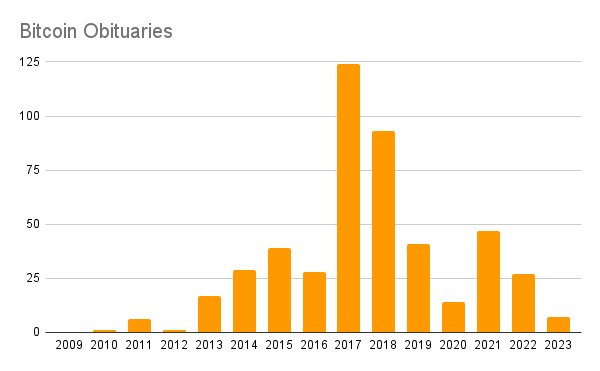
Recognising Bitcoin as an investment asset, prominent financiers such as Larry Fink, head of the world's largest investment company BlackRock, and Stanley Druckenmiller, one of the world's most effective money managers, have spoken out in its defence this year.
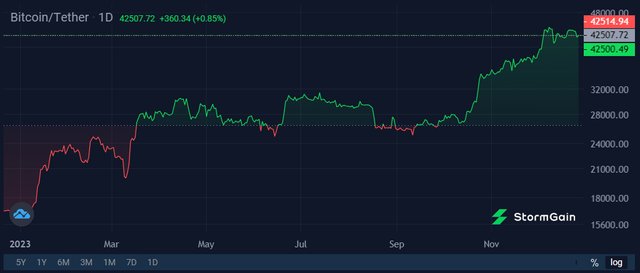
This year turned out to see a host of events that, for the most part, were positive for cryptocurrencies. The new year, 2024, is expected to be no less exciting.
StormGain Analytical Group (https://stormgain.com/)
(platform for trading, exchanging and storing cryptocurrency)
57
« on: December 21, 2023, 09:34:45 AM »
Ordinals aren't the only thing to blame for Bitcoin's high network fees
In 2023, a significant increase in transactions was caused by the Ordinals protocol, which allows digital objects to be exchanged over the Bitcoin network due to the numbering of satoshis. The first wave of interest in Ordinals came in the spring when the bulk was represented by visual images. In the second wave, interest shifted to meme coins, and the excitement was so intense that, on some days, they accounted for over half of all transactions.
Ordinals boosted the number of transactions processed to previously unseen levels.

So many transactions were completed due to the small space occupied by quasi-tokens in a block. While a large image may require the entire block, tokens, on the contrary, fill the free areas like grains of sand due to their technical specifics.
Despite the hype and large volume of operations involving them, Ordinals have consumed less than 20% of the block space since July.
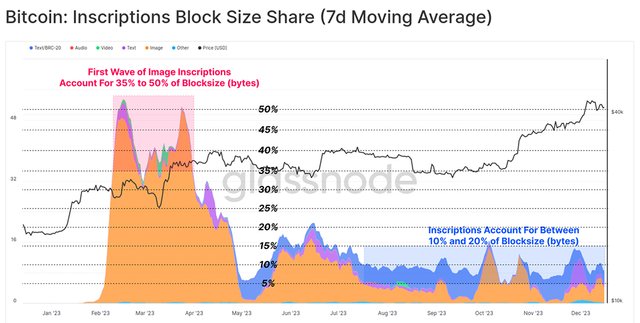
The rest of the space is taken up by financial transfers, the weight of which varies greatly with the number of deposits and withdrawals. In December, monetary transactions reached 373,000 per day, the highest level since mid-2019.
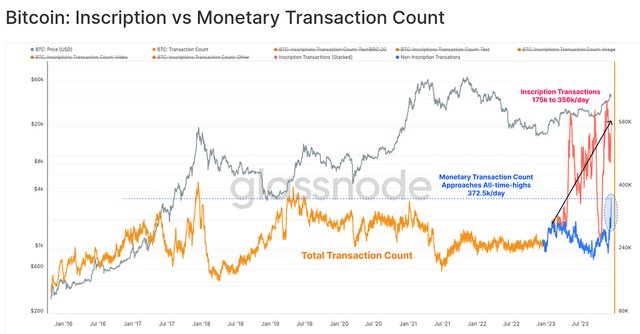
The activation of market participants is driven by expectations of the upcoming approval of Bitcoin spot ETFs in the US, the halving event in April 2024 and a new bull season.
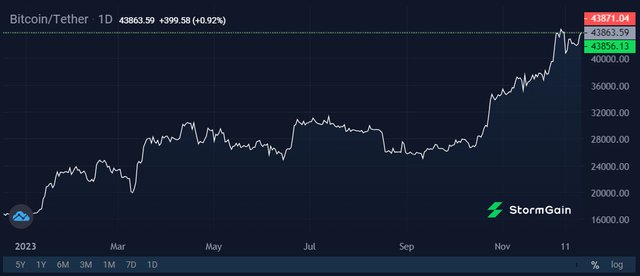
The trend is also evident in the increased interest in spot trading that crypto exchanges see in Bitcoin and Ethereum inflows/outflows.
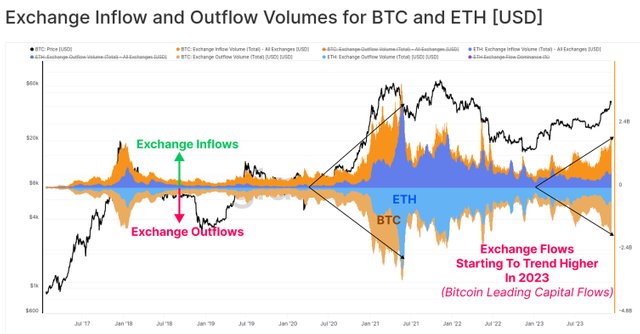
Despite the large number of transactions, quasi-tokens don't occupy much space in the block. Financial transactions account for the main competition for space in blocks. On 17 December, the average fee reached $37, a level last seen in April 2021. The trend will likely continue as new participants get involved and the market grows.
This problem can be solved by increasing the block size, which some developers are already calling for. Others see Ordinals and high fees as an encouragement for developing second-tier networks.
StormGain Analytical Group (https://stormgain.com/)
(platform for trading, exchanging and storing cryptocurrency)
58
« on: December 20, 2023, 03:31:43 PM »
Ethereum faces another threat in 2024
After transitioning to PoS, the second-largest cryptocurrency faced a series of new challenges, the key one among them being the SEC's active enforcement policy. American crypto exchanges, which collectively accounted for more than a third of staked ETH, received pre-enforcement action notifications. Most of them agreed to the deal, which resulted in them closing off access to staking for retail investors. Kraken and Coinbase saw combined withdrawals of 40% or 2 million ETH (about $4.5 billion).
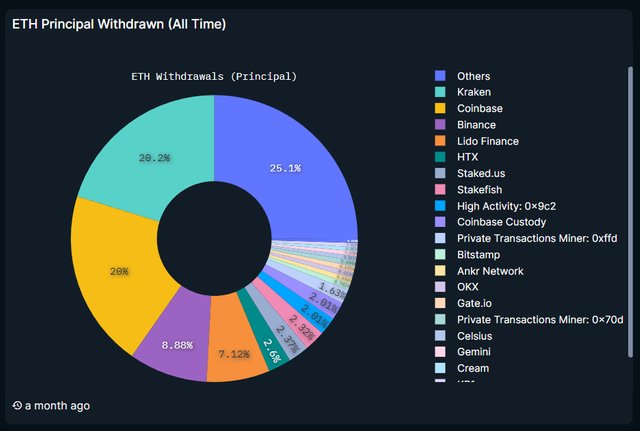
The drop in Ethereum's attractiveness as an investment for Americans made it weaker compared to both other altcoins and Bitcoin. In 2023, it lost 28% to Bitcoin, which is usually characteristic of a bear market.
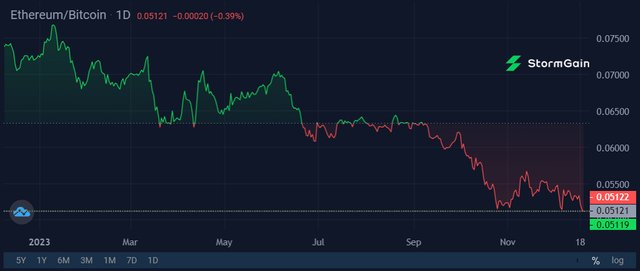
This serious lag couldn't be compensated for with the staking programme, the annual yield of which isn't even 4%. As a result, the queue of those wishing to stake ETH has sharply decreased. Now, the wait time to connect is less than one day.
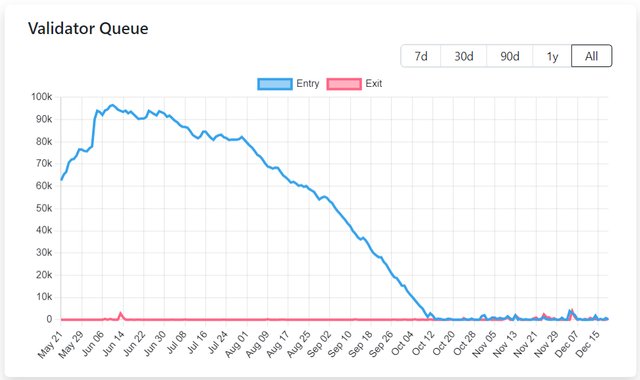
Another problem stemming from the transition to PoS is the network's growing centralisation. The Lido Finance platform now accounts for 32% of all staked funds and an impressive 77% in the liquid staking derivatives market. Liquid stakes are a programme that provides one's own token to replace staked ETH. Lido issues stETH, which is freely quoted in the cryptocurrency market.
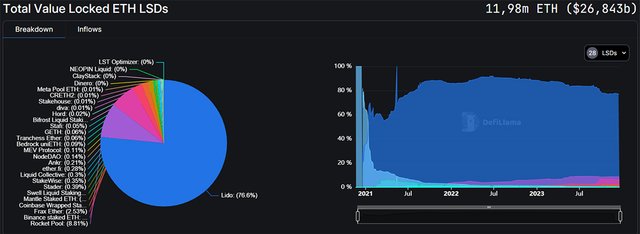
For Ethereum, stETH's significant weight poses a systemic risk, as the collapse of the token will likely lead to turbulence among all interrelated assets. As a result, it's worth focusing on LDO, the parent token from Lido.
On 17 December, private investors in LDO filed a class action lawsuit against Lido Finance in the United States District Court for the Northern District of California's San Francisco Division. Their suit claims that they suffered losses as a result of the company's policies. The claim boils down to the fact that the token was released to the market at large after LDO was distributed to developers and early institutional investors. Two months after being listed on crypto exchanges, the token collapsed from $3 to $0.60.
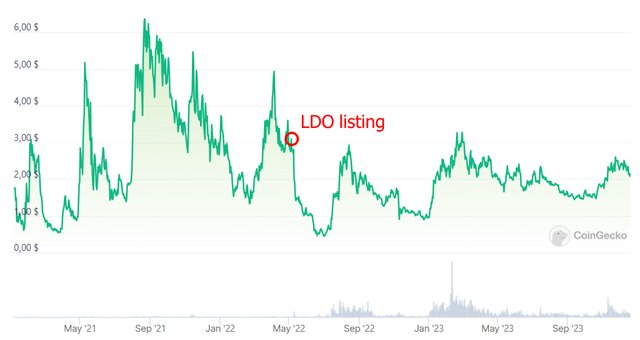
The plaintiffs are asking for LDO as a security as the company acted out of "the expectation of profit from the actions of the management team." This is one of the points of the Howey Test that the SEC uses to determine the status of an asset. The lawsuit also notes that retail investors are unable to influence decisions since 64% of tokens are concentrated in the hands of developers and early investors.
If the court sides with the plaintiffs in 2024, the consequences for Lido could be very unfavourable. This, in turn, will negatively impact Ethereum.
StormGain Analytical Group (https://stormgain.com/)
(platform for trading, exchanging and storing cryptocurrency)
59
« on: December 19, 2023, 10:03:16 AM »
Bitcoin's fee hike leads to increased demand for Litecoin
On 17 December, the average fee in the Bitcoin network set a one-year high, reaching $37. Binance contributed by listing ORDI in November. As a result, the token's price rose ten-fold. The average fee has seen a six-fold growth during the same time.

Once again, Ordinals, which facilitate over half of all transactions, were the reason for this rise in costs. Ordinals are artefacts within a network, such as images or other digital objects. The Ordinals protocol was introduced in February by developer Casey Rodamor. Months later, he apologised to the community because of the surge in spam on the network.
Since May, the primary volume of Ordinals has been represented by quasi-tokens or meme coins (similar to ERC-20 coins on the Ethereum network). They don't carry a payload, and all the hype is associated with speculative expectations. Coins now account for 99% of transactions among Ordinals.
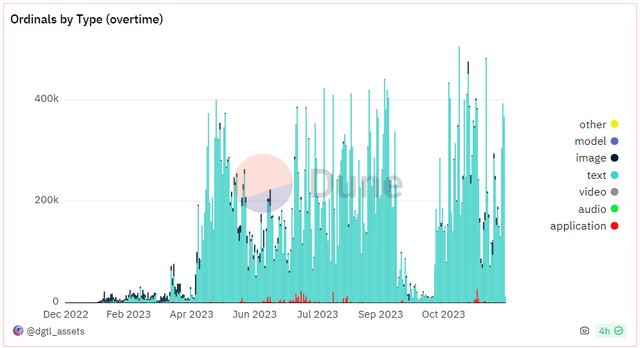
Advocates of developing the network conservatively have condemned the new sphere, with Bitcoin Core developer Luke Dashjr threatening miners with a PoW algorithm change if they don't start filtering transactions. Ocean Mining, the pool he founded, has previously admitted that it filters out Ordinals.
However, the likelihood of changing the algorithm is extremely low since not everyone supports such radical decisions. Some participants see the emergence of Ordinals as a natural stage of evolution, which increases the demand for transactions in the network, leads to a rise in income for miners and, due to their greater involvement, improves security.
Thanks to Ordinals and the rising value of the cryptocurrency, the yield from the power terahash hit a new one-year high yesterday at $0.13.
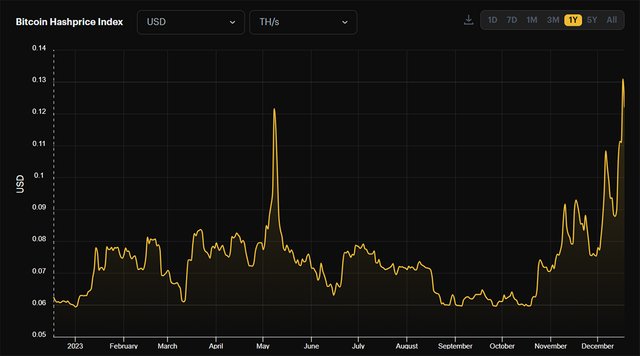
The downside of the high fees is a declining interest in Bitcoin as a means of payment. In May, after similar events took place, the use of Litecoin skyrocketed. The latter is similar to Bitcoin in most technical parameters, but the average transaction fee is less than $0.01.
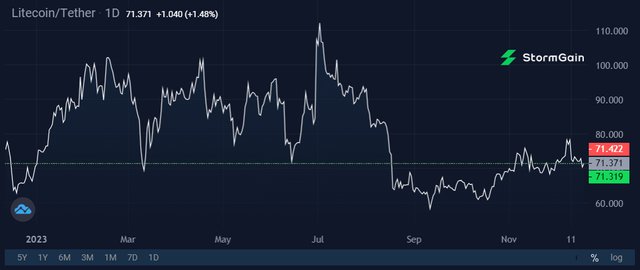
In November, the number of completed transactions set a new record.

If the Ordinals hype doesn't calm down soon, increased demand for transactions involving Litecoin will cause the coin's value to rise.
StormGain Analytical Group (https://stormgain.com/)
(platform for trading, exchanging and storing cryptocurrency)
60
« on: December 18, 2023, 08:31:30 AM »
Crypto market drops, but analysts predict new era for Bitcoin and Co.
During Monday's trading session, the cryptocurrency futures market experienced significant turbulence, resulting in losses exceeding $500 million in liquidated positions for highly leveraged long and short trades. The intense volatility affected major cryptocurrencies, with some witnessing drops as substantial as 12%.
Bitcoin (BTC) traders were in for a roller-coaster ride as the original cryptocurrency oscillated between $43,000 and a low of $40,300, wiping out almost a week of gains and exerting a downward pull of the wider crypto market, including prominent tokens like Chainlink (LINK), Cardano (ADA), and Solana's (SOL), which saw declines exceeding 8% before a modest recovery. Notably, riskier assets such as Shiba Inu (SHIB) and Dogecoin (DOGE), both meme tokens with dog themes, experienced a comparatively milder 5% drop. In contrast, Avalanche (AVAX) managed to buck the trend, registering gains of up to 20% despite Bitcoin's weakness.
Over $500 million in 'rekt' positions liquidated
The market downturn led to losses of nearly $475 million in long positions (bets on higher prices) and $73 million in short positions (bets against), reflecting a general unwinding of leveraged positions amid elevated funding rates, creating an unstable market environment.
Liquidations transpire when an exchange forcibly closes a trader's leveraged position due to a partial or total loss of the initial margin. This occurs when a trader cannot meet the margin requirements, lacking sufficient funds to sustain the open trade.
What caused the crash?
There is no simple answer as to why the market started the week with such a sharp correction, but there could be several factors at play.
Firstly, traders could simply be taking profit and cashing in on the week's gains, which creates pressure to sell. Another issue may be an excess of leveraged positions in the market. When traders employ excessive leverage, they are essentially engaging in trades with borrowed funds. While leverage can be advantageous, it comes with risks that can be detrimental when the market turns unfavourable. In the event of price drops, these traders are at risk of being completely wiped out, i.e., liquidated, which can have a significant impact on the broader market.
Does Bitcoin still have a future? All fundamentals point to yes
Despite the recent market upheaval, most market analysts are still bullish on Bitcoin, pointing to the range of recent developments in the Bitcoin ecosystem, including Ordinals and Layer-2 solutions, the high level of interest in Bitcoin spot exchange-traded funds (ETFs), and the next halving event anticipated in Q4 2024.
BTC prices started moving upward again in October after nearly half a year of sideways price action, gaining around 50% within the last month and 150% since the start of this year. On-chain data also shows evidence of whale accumulation, with consistent BTC purchases by accounts holding over 1 BTC.
Institutional investors are increasingly throwing their weight behind Bitcoin, and so are sovereign nations. El Salvador's eagerly awaited Bitcoin bonds, referred to as "Volcano Bonds", have reportedly obtained regulatory approval for their introduction in early 2024.
The Digital Assets Commission of El Salvador has purportedly given the green light to the Volcano Bond, with an expected launch slated for the first quarter of 2024, as outlined in a statement from the country's National Bitcoin Office (ONBTC) on 11 December.
El Salvador marked a significant milestone on 11 January by enacting groundbreaking legislation that established the legal framework for the Bitcoin-backed bond. The primary purpose of the Volcano Bond is to retire sovereign debt and finance the development of the country's proposed "Bitcoin City", with the name of the bond being a reference to President Nayib Bukele's plan to leverage volcanic energy to power Bitcoin mining.
All things considered, things don't look bad for BTC in the long term. Despite being the oldest cryptocurrency, with many pretenders to the throne competing on utility, energy efficiency, or meme factor, Bitcoin is demonstrating remarkable resilience as both a digital asset and a platform.
Staying cool during the market correction
Veteran traders will already be well aware of this, but everyone with positions in the crypto market should be prepared to take a deep breath and calmly weather this latest wobble in prices.
Volatility returning to the digital asset market can be seen as a positive sign. After all, volatility is why crypto made so many overnight millionaires and excited investors around the world in the first place. A market correction is normal after a bullish surge, and after the weaker and over-leveraged positions have been liquidated, a period of stable gains has often followed. Volatility can swing both ways, and the wise trader will watch the crypto market and the wider macroeconomic environment to take advantage of the next trend.
Get the best perks for trading BTC and more with StormGain
The increased backing from institutional investors, a growing interest in spot ETFs, and the anticipation surrounding next year's halving event are all setting up the next few months to be an important time in crypto history. For individuals seeking to profit from the future price fluctuations of cryptocurrencies, StormGain offers optimal conditions for beginners and experienced traders alike.
Available on the web or a user-friendly smartphone app, StormGain is a comprehensive crypto trading and investment platform, granting round-the-clock access to the top assets in the global cryptocurrency market. To help you maximise your gains, StormGain provides all the essential tools for success, including trading signals, competitive fees, a range of educational resources, and secure crypto wallets. StormGain users even benefit from an integrated Bitcoin cloud mining feature that earns free BTC just for being active on the platform. If you haven't joined StormGain yet, take a few seconds to register and try a demo account to see how StormGain can start you on your journey to cryptocurrency trading profits! (https://stormgain.com/easy-start)
Pages: 1 2 3 [4] 5 6 ... 37
ETH & ERC20 Tokens Donations: 0x2143F7146F0AadC0F9d85ea98F23273Da0e002Ab
BNB & BEP20 Tokens Donations:
0xcbDAB774B5659cB905d4db5487F9e2057b96147F
BTC Donations:
bc1qjf99wr3dz9jn9fr43q28x0r50zeyxewcq8swng
BTC Tips for Moderators:
1Pz1S3d4Aiq7QE4m3MmuoUPEvKaAYbZRoG



 Latest news:
Latest news: 





 Shop
Shop